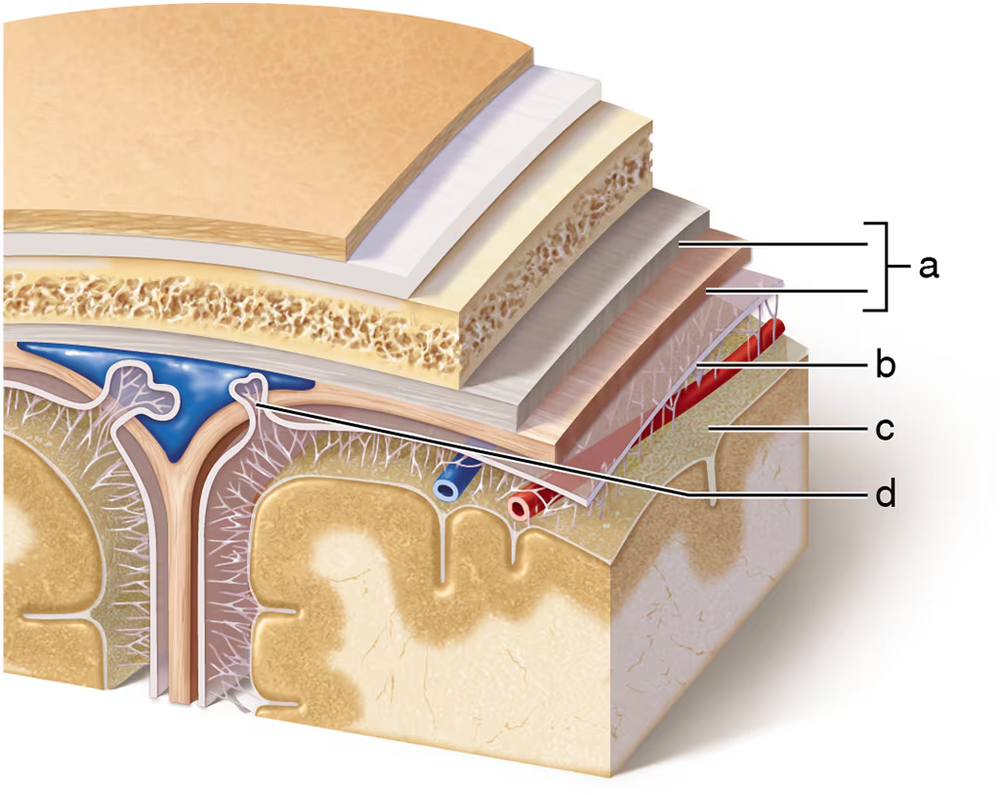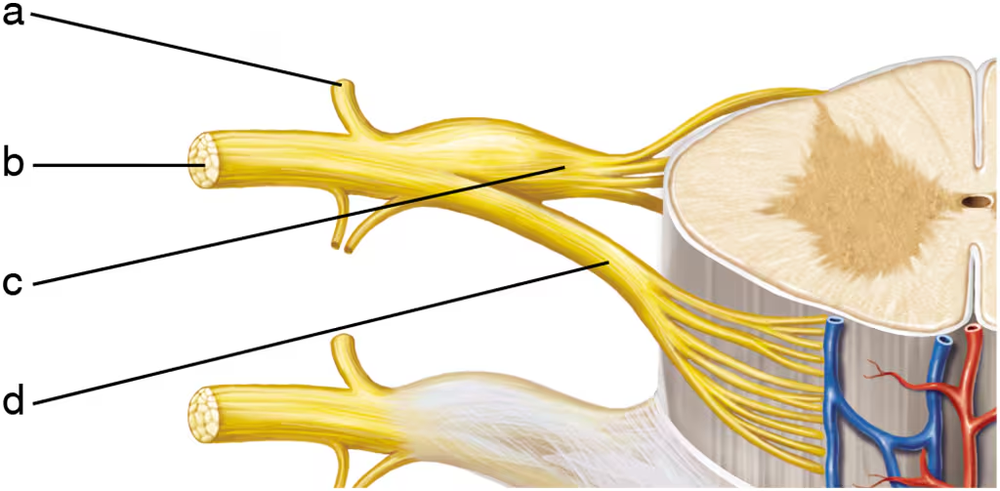 Back
BackProblem 3
Which is the innermost delicate meningeal layer?
Problem 4
Histological examination of a slice of neural tissue reveals a bundle of nerve fibers held together by cells whose multiple processes wrap around several fibers and form a myelin sheath. The specimen is likely to be:
a. A nucleus
b. A ganglion
c. A nerve
d. A tract
Problem 5
The pineal gland is located in the:
a. Hypothalamus
b. Mesencephalon
c. Epithalamus
d. Corpus callosum
Problem 6a
Choose the proper term to respond to the statements describing various brain areas.
a. Cerebellum
b. Corpora quadrigemina
c. Corpus callosum
d. Hypothalamus
e. Medulla
f. Midbrain
g. Pons
h. Thalamus
1. Region where there is a gross crossover of fibers of descending pyramidal tracts
Problem 6b
Choose the proper term to respond to the statements describing various brain areas.
a. Cerebellum
b. Corpora quadrigemina
c. Corpus callosum
d. Hypothalamus
e. Medulla
f. Midbrain
g. Pons
h. Thalamus
2. Control of temperature, autonomic nervous system reflexes, hunger, and water balance
Problem 6c
Choose the proper term to respond to the statements describing various brain areas.
a. Cerebellum
b. Corpora quadrigemina
c. Corpus callosum
d. Hypothalamus
e. Medulla
f. Midbrain
g. Pons
h. Thalamus
3. Houses the substantia nigra and cerebral aqueduct
Problem 6d
Choose the proper term to respond to the statements describing various brain areas.
a. Cerebellum
b. Corpora quadrigemina
c. Corpus callosum
d. Hypothalamus
e. Medulla
f. Midbrain
g. Pons
h. Thalamus
4. Relay stations for visual and auditory stimuli input; found the mid-brain
Problem 6f
Choose the proper term to respond to the statements describing various brain areas.
a. Cerebellum
b. Corpora quadrigemina
c. Corpus callosum
d. Hypothalamus
e. Medulla
f. Midbrain
g. Pons
h. Thalamus
6. Brain area through which all the sensory input is relayed to get to the cerebral cortex
Problem 6g
Choose the proper term to respond to the statements describing various brain areas.
a. Cerebellum
b. Corpora quadrigemina
c. Corpus callosum
d. Hypothalamus
e. Medulla
f. Midbrain
g. Pons
h. Thalamus
7. Brain area most concerned with equilibrium, body posture, and coordination of motor activity.
Problem 8
Which contains only motor fibers?
Problem 9
Cranial nerves that have some function in vision include the:
a. Trochlear
b. Trigeminal
c. Abducens
d. Facial.
Problem 10
Motor functions of the extensor muscles of the arm, forearm, and fingers would be affected by damage to which one of these nerves?
a. Radial
b. Axillary
c. Ulnar
d. Median
Problem 11
Neuroglia present in large numbers in areas of bacterial infection in the brain are most likely:
a. Oligodendrocytes
b. Astrocytes
c. Ependymal cells
d. Microglia
Problem 12
Which of the following is true of the autonomic, but not the somatic, nervous system?
a. Neurotransmitter is acetylcholine
b. Axons are myelinated
c. Effectors are muscle cells
d. It has motor neurons located in ganglia
Problem 13
Explain both the structural and functional classifications of the nervous system. In your explanation, include the subdivisions of each.
Problem 14
What is the basis for the functional classification of neurons?
Problem 15
Two major cell groups make up the nervous system—neurons and supporting cells such as astrocytes and Schwann cells. Which are 'nervous' cells?
Why? What are the major functions of the other cell group?
Problem 16
Briefly explain how nerve impulses are initiated and transmitted, and why conduction at synapses is always one-way.
Problem 17
Other than serving as a conduction pathway, what is a major function of the pons? Why is the medulla oblongata the most vital part of the brain?
Problem 18
How many pairs of cranial nerves are there? Which are purely sensory? Which activates the chewing muscles? Which helps regulate heart rate and activity of the digestive tract?
Problem 19
What region of the body is served by the dorsal rami of the spinal nerves? By the ventral rami?
Problem 20
Name the four major nerve plexuses formed by the ventral rami and the body region served by each.
Problem 21
Joseph, a man in his early 70s, was having problems chewing his food. He was asked to stick out his tongue. It deviated to the right, and its right side was quite wasted. What cranial nerve was impaired?
Problem 22
A semiconscious young woman is brought to the hospital by friends after falling from a roof. She did not lose consciousness immediately, and she was initially lucid. After a while, though, she became confused and then unresponsive. What is a likely explanation of her condition?
Problem 23
Mrs. Chen, a new mother, brings her infant to the clinic because he has suffered repeated seizures. When questioned, she states that her labor was unusually long and difficult. What condition do you suspect? Will the infant's condition worsen?
Problem 24
Clarence, an elderly man with a history of TIAs, complained to his daughter that he had a severe headache. Shortly thereafter, he lapsed into a coma. At the hospital, he was diagnosed as having a brain hemorrhage. Which part of the brain was damaged by the hemorrhage?


